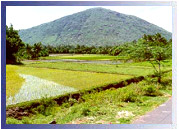
The
Dravidain culture of tamil nadu is a anciet and complex as any the world has
known. Among the great dynasties of south India that held sway here the Chola
Kings are synonymous with power and compassion, magnificent temples and delicate
bronze images of their deities.
Tamil Nadu is rich in mineral resources like limestone, bauxite, lignite,
magnesite and iron ore. Cotton spinning and weaving are the major industries
besides fertilizers, cement, paper, chemicals and electric motors. It ranks
second (first being Kerala) in the production of fish. The most important
river is the Cauvery which is an important source of water and power.
Places to Visit in Tamil Nadu
Chennai
The capital of Tamil Nadu, is one of the four major metropolitan cities in
India and main centre of this region. In the early 17th century, Madraspatnam
was the small fishing village along the cooum and Adyur rivers flowed towards
the coromandel coast and into the Bay of Bengal. Chennai is a city that never
hurries. compared with India's other major cities, Chennai is quiet backwater,
conservative in its way, with consierable importance placed on old fashioned
values and traditions.
The thirteen kilometers long marvelous Marina beach that wears a festive look
on weekend evenings adds more beauty to the Chennai city are the finest and
longest beaches in the world. Theaquarium is on the sea front. The state secretariat
of the St. George Forte in Chennai is a splendid building. The variety of
British and French antiques and other commemorations in the museum are popular
amongst tourists. The first English church in Chennai, St Mary's Church gives
peace to mind and soul. A tour to Chennai would introduce us to some of the
important places like, the 8th century Parthasarthi temple of the Pallavas
dedicated to Lord Krishna and the Kapaleeswarar Temple of Lord Shiva
Other tourist attraction of Chennai.
High Court: is one of the largest judicial complexes in the world.
The Art and Bronze Gallery: where one can find few examples of the Tanjore
school of painting.
Snake Park: A tour of this fascinating park will reveal that more than 40
species of common snakes besides crocodiles, chameleons, monitor lizards and
tortoises can be seen here.
Fort Museum: It is at Fort St George, the first British fort build around
1653 by the British East India Company. The padlocks, old uniforms, old prints,
palanquins, paintings of the governors are displayed here.
Kanchipuram
Kanchipuram is lieas towards 76 kms Southwest of the Chennai. This golden
city of thousand temple is one of the seven most scared cities of India. Kanchi
is also called Varanasi of the south" and is held in great reverence.
Kanchipuram was the capital of succesive south India dynasties beginning with
pallavas, the Cholas, and the Rayas of Vijayanagar. During the 6th and 7th
centuries, the Pallavas built some of the best temples in the city.
The city was also a great seat of learning. Sri Sankaracharya, Appar, Siruthonder,
and the great Budddhist Bhikku lived, and worked here. Kancipuram is also
famous for its finest hand woven silk fabrics and silk kanchipuram saris.
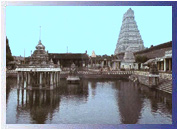
The
main attraction and famous temples of the city are Kailasnath Temple, built
by Rajasimha and his son Mahendra the 3rd, in the 8th centuryAD. Ekambareswarar
Temple, another ancient temple, renovated by the Pallavas, the Cholas, and
the Vijayanagar kings. The 57 metre high Rajagopuram, is one of the tallest
towers in South India. The festivals of the city are celebrated with great
pomp and show; some of the main festivals are the Brahmothsavam, Garudothsavam,
and the Chariot festival. Sakkiswarar Temple; built by the Cholas.This temple
is located near the Kamakshi Amman Temple.Vaikuntha Perumal Temple, an important
Vishnu temple built by the Pallava King Nandivarman Pallavamalla, in the 7th
century AD. Numerous inscriptions are found in the temple, relating to the
wars between the Pallavas and the Chalukyas.
Mahabalipuram
Mahabalipuram also known as Mamallapuram, this coastal town was a famous sea
port founded by Pallavan king in the 17 th century. This city is famous for
its seven pagodas - a group of ancient rock temples, which are examples of
the Dravidian style of architecture. At the mouth of the river palar on a
large granite hall about 1km in length from north to south, is the site of
many monuments.
This ancient Pallava port, is today the sight of several antique sculptural
marvels. In this ancient seaside town, shrines and huge sculptures cut-out
of rocks more than 1200 years back during the reign of Pallava Kings are The
Descent of Ganges also known as Arjuna's Penance, this open air sculpture
showing the descent of the holy river, Krishna Mandap (Lord krishna lifting
the Mount Goverdhan), The Rathas (dedicated the five Pandavas, showing fine
chariots) and the Shore temple dedicated to Lord Shiva. (This all are the
World heritage sites).
Chidambaram
If you travel 245 kms away from Chennai, you will reach Chidambaram, also
known as the 'City of the Cosmic Dancer' or called as Thillai. Chidambaram
is an important destination for followers of the Hindu god Shiva and exponent
of the fearsome, frenzied Tandav Nritya or the dance of destruction. At the
centre of the town is the large Natraj Temple (the dancing Shiva)' in his
cosmic dance pose is known through out the world. 'The Chitrakootam', another
shrine adjacent to the Nataraja temple is dedicated to Lord Govindraja. Spread
out over 40 acres this complex, dedicated to the god who is usually represented
by the phallic symbol, houses other temples, a tank, and the 'thousand pillared
hall’. Non-Hindus are allowed into the complex but not the gold plated
sanctum sanctorum that houses the idol. The Natyanjali Dance Festival is held
on the temple grounds in February with performances by eminent dancers. There
is a 13th century Kali Temple on the outskirts of the town.
Madurai
Madurai is also one of the ancient most citis of India. The name "Madurai"
is said to be corruption of mathuram,"nector", a name given t the
city after a drop of nector fell from Shiv's hair. Madurai is great temple
town and renowned for its Meenakashi temple situated on the banks of river
Vaigai. Madurai has a rich cultural heritage, which is more than 2500 years
old. The city is believed to have been built by the Pandyan King, Kulasekara
in the 6th century BC. It is also known as the Athens of the East and is the
second largest city in Tamil Nadu. The temple measuring 255 metres by 217
metres and punctuated by four gateways within the heart of the city. There
are two main shrines, one dedicated to Meenakshi Amman and other to Shiva
Sundereswara, her lord. Temple gives a splendid example of Dravidian architecture
and to its left is Golden Lotus Pool, surrounded by colonnade wher pilgrimges
baths and do ablutions and also is famous for Jasmine Flowers.

The
present temple was designed in 1560 by Vishwanatha Nayak and subsequently
built during the reign of Tirumalai Nayak. There are four entrances to the
temple with an area of six hectares. Each of its 12 towers has the height
of 45 to 50 meters. The temple museum has 985 richly carved pillars and each
one surpasses the other in beauty.
The Vishnu Temple is located at a distance of 21 kms northwest of Madurai.
It is said that in this temple, 'Vishnu' presides as Meenakshi's brother 'Azhgar'.
During the Chitrai festival a procession is carried out from Azhagar Kovil
to Madurai for wedding ritual.
Palamudhirsolai, one of the six abodes of Lord Subramanya is on the same hill.
A natural spring called Nuburagangai is also located here.
Coimbatore
Coimbatore is the third largest city in Tamil Nadu after Chennai and Madurai.
It’s a lot like the rest of industrial India in essence but without the
grey smoke-urban sprawl flavour. Surprisingly, it’s a pleasant mix of
busy bustle and small town ease despite being the business hub of textile
and automobile industries in South India. it is also known as the 'Manchester
of South India'.
Kodaikanal
About 120 kms from Madurai, situated this scenic hill station in Tamil Nadu,
famous for 'The Kurinji flower', which blossoms once in 12 years. Set 2100
metres above sea level, Kodaikanal is a popular hill station retreat in South
India. The cool climes of Kodai offer holiday makers respite from the steamy
plains of Tamil Nadu and other neighbouring states. Encompassed by verdant
slopes that are punctuated by waterfalls and cascades, Kodaikanal presents
some awesome scenic views of the plains below. the natural beauty of Kodai.
There are organized walks through the eucalyptus and blue gum forests that
are great for the heart, mind and lungs. One can go off on one’s own
exploring the surrounding hills. The surrounding forests provide great trekking
trails for the outdoor enthusiast and if you are not too adventurous, the
Kodai Lake located at the heart of the town is the perfect place to take a
leisurely stroll or boat ride.
Kodaikanal was established by American missionaries around 1845, a refuge
from inhospitable climes and the dreaded malaria. Besides being an escape
from the heat, the town is also filled with residential schools. Today it
has some of the best residential schools in the country, with the Kodaikanal
International School leading the pack.
The most important tourist attractions are coachker's Walk, Golf Links, Green
Valley view, Pillar's rocks, silver cascade falls and the Kodai Lake, various
water falls and the Solar Physical Observatory.
Visit Kodaikanal from April to June or August to September. This is when the
weather is at it's best - temperatures stay in the region of a comfortable
20°C to a bracing 10°C. The months between October and March are wet
and cold, so it is best to avoid being here at this time.
Ooty (Ootacmund)
Ootacamund most popularly known as Ooty. It is mostly referred to as the
Queen of the Southern Hills stations. located in the midst of four high hills;
Doddabetta, Snowdon, Elk hill and Club Hill. .It drives its name from the
Niligiri or the Blue Mountains - the name to the Hills by the inhabitants
for more than 850 years because of the blue haze of clouds which envelope
the hill slopes. Hill slopes veiled in a profusion of wild flowers, plantations
of cardamom and tea, and eucalyptus forests take over the landscape.
Ooty offers the most scenic walks, into dense forests, pretty mountain trails
and to fabulous viewpoints like Wenlock Downs, Snowdon, Ketty Valley and Dodabetta
Peak. From here you can sweep across the Blue Mountains, wander through the
misty forests, chance upon unexpected waterfalls and brilliant bird species.
Canter away on ponies or have a romantic little picnic in the woods.
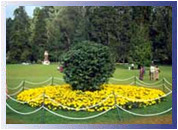
Ooty
is tranquil enough for a pair of lovebirds to get lost among the other dreamers
who are seeking quiet havens and parks. Look for secluded corners in the Botanical
Garden with its amazing collection of trees and shrubs, and the beautiful
Rose Garden. For times when you want to join in the action, walk down to the
lake and soak in the excitement from the safety of the banks or venture onto
the lake and tandem in pedal boats, rock together in rowboats and motorboats.
And finally, catch the picturesque little Blue Train, a beautiful journey
through tea plantations, eucalyptus forests and hills.
Rameshwaram
Rameshwaram is an island situated on the tip of the Indian peninsula and the
most sacred temple town of India is an island hallowed by the epic Ramayana.
It is the place from where Lord Rama had built a bridge across the sea to
rescue his consort Sita.This is the place where Rama worshipped Lord Shiva
and erected lingam to cleanse away the sin of Ravana. Both the Vaishnavites
and Shaivites visit this pilgrimage city.
Rameshwaram is significant for the Hindus. The presiding deity is the Linga
of Sri Ranganatha, which happens to be one of the twelve Jyotirlingas of India.
Rameshwaram is popularly referred as the 'Benaras of the south'. In order
to attain Moksha it is believed that a visit to Rameshwaram is mandatory.
In fact the entire area of Rameshwaram is associated with various incidents
from the Ramayana. The city of Rameshwaram happens to be one of the most visited
pilgrim sites in India.
The Ramanathaswami Temple is about a hundred meters from the shore. It marks
the place where Rama is said to have earned Shiva’s forgiveness for killing
Ravana. The temple is huge with a 54meter high gopuram and a corridor that
is 1220meters long, lined with 1200 huge granite pillars. The Agni Teertham
is when devotees purify themselves in the seawater around. The temple complex
has 22 wells, each of which is supposed to have different tasting water. Gandamadham
Parvatham is the highest point in the island. The hall has a wheel (chakra)
which bears a footprint believed to be Rama’s. 8km from Rameswaram is
the southern tip of the island called Dhanushkodi after Rama’s bow. The
boulders around are believed to be from the bridge that Rama’s monkey
army built to get across to the errant Ravana’s Lanka. Devastated by
a cyclone in 1964, all that remains here is an ancient temple and its idols
of figures from the epic .Another shrine called Gandamadana Parvatham is worth
visiting. This shrine is found at 2kms away from Rameshwaram
Thanjavur(Tanjore)
Thanjavur, or Tanjore as the Britishs called it, is a lush paddy district.
Now a small city in the state of Tamil Nadu, it rose to glory during the Chola
period from the 10th century to the 14th, when it came to be the centre of
art and education. The Cholas built extensively during this period and 74
of their temples are still standing. As the centre of cultural development
Thanjavur attracted master craftsmen, and it still continues to produce attractive
handcrafted ware. It is an important center for bronze figure casting. Thanjavur
is known for the beautiful Brihadeshwara temple. Other places that can be
seen are 'The Raja Museum and Art Gallery' and 'Saraswati Mahal Library, 16
th century Shivganga Fort.
Trichy (Tiruchirapalli)
One of the most famous temple town situated on the banks of the Cauvery river,
325 kms away from Chennai, this city is known for its historic temple architecture,.
blend of history and tradition as well as pilgrim centre. Historically, trichys
prosperty was linked to the fortunes of South Inida's ruling dynasties. The
city generally associated with the Chola's , The Pallavas, Pandyans and Nayaks.
The most famous attractions to visit are Ranganath temple and Jambukeshwar
Temple at Srirangam and Rock fort and its temple at a height of over 23mts.
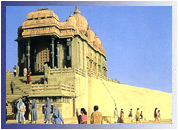 Kanyakumari
Kanyakumari
Kanyakumari – is the land’s end of India where the water of the
Arabian Sea , the Bay of Bengal and the Indian Ocean meet. It is noted for
its marvelous beaches and spectacular sunrises and sunsets. An important pilgrim
centre of India. Upon arrival check in at hotel.
Kanyakumari has been named after the Goddess Amman, who is the popular deity
of the area. It is said that the Goddess Parvati in one of her incarnations
did penance on one of the rocks of this land's end to obtain the hand of Lord
Shiva. The district was once known as "The Granary of Travancore".
It was in Travancore for a long time and then merged with Tamil Nadu in 1956
under the State Linguistic Reorganization Act and to its South – East
lies the famous Vivekananda Rock Memorial, a blend of all the architectural
styles of India. Vattakottai, Suchindram and Courtallam Falls.
Kanyakumari is also known as Cape Comorin. The Cape festival is celebrated
on a large scale for three days at Kanyakumari. The festival is marked by
a series of cultural programs.
Pondicherry
Pondicherry is situated on the Coromandel Coast of South India, about 160
kms south of Chennai.It is touched by the Bay of Bengal on the east and on
the other three sides by the South Arcot District of Tamil Nadu. Pondicherry
comprises the towns of Karaikal, on the east coast; Mahe, which is situated
on the Malabar Coast, and Yanam, situated further up the east coast. Pondicherry
a former french enclave and a provincial town. it carries a strong whiff of
the French presence in India. Legend says that Pondicherry is the place where
St.Agasthaya settled down.
Palaces of tourist attraction
Beaches:
Pondicherry has a lovely beach, which is about 1.5 Kms long. One can relax,
sunbathe, swim, or take a stroll along the promenade. The beach has historical
connections too.
Boat House:
Facilities for boating are available at the Boat House on the River Chunnambar.
The backwaters and the lush greenery on both sides of the Chunnambar River
provide an ideal setting for boating tours. Boats are available for hire by
tourists on all days of the week.
Sri Aurobindo Ashram:
Sri Aurobindo Ashram, situated in the eastern part of Pondicherry. A tour
of this samadhi of Shri Aurobindo and his chief disciple, the Mother is worth
making. It is not only a quiet place of retreat but also a vibrant center
of life. It comprises of almost 1500 members who live here and practice Sadhna
for the evolution of another way of life, which seeks a higher spiritual consciousness.
Many tourists travel to Pondicherry to visit this internationally renowned
Ashram.
some other places to see :
Auroville - a unique experiment in international living and in creating a
new environment where men and women of all nationalities live together in
harmony; Vardaraja Perumal Temple, Vedapureeswarar Temple & Manakula Vinayagar
Templewar memorial, Town hall
::
Click
here for Reservation
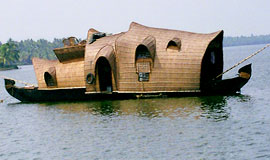
 The
Dravidain culture of tamil nadu is a anciet and complex as any the world has
known. Among the great dynasties of south India that held sway here the Chola
Kings are synonymous with power and compassion, magnificent temples and delicate
bronze images of their deities.
The
Dravidain culture of tamil nadu is a anciet and complex as any the world has
known. Among the great dynasties of south India that held sway here the Chola
Kings are synonymous with power and compassion, magnificent temples and delicate
bronze images of their deities. The
main attraction and famous temples of the city are Kailasnath Temple, built
by Rajasimha and his son Mahendra the 3rd, in the 8th centuryAD. Ekambareswarar
Temple, another ancient temple, renovated by the Pallavas, the Cholas, and
the Vijayanagar kings. The 57 metre high Rajagopuram, is one of the tallest
towers in South India. The festivals of the city are celebrated with great
pomp and show; some of the main festivals are the Brahmothsavam, Garudothsavam,
and the Chariot festival. Sakkiswarar Temple; built by the Cholas.This temple
is located near the Kamakshi Amman Temple.Vaikuntha Perumal Temple, an important
Vishnu temple built by the Pallava King Nandivarman Pallavamalla, in the 7th
century AD. Numerous inscriptions are found in the temple, relating to the
wars between the Pallavas and the Chalukyas.
The
main attraction and famous temples of the city are Kailasnath Temple, built
by Rajasimha and his son Mahendra the 3rd, in the 8th centuryAD. Ekambareswarar
Temple, another ancient temple, renovated by the Pallavas, the Cholas, and
the Vijayanagar kings. The 57 metre high Rajagopuram, is one of the tallest
towers in South India. The festivals of the city are celebrated with great
pomp and show; some of the main festivals are the Brahmothsavam, Garudothsavam,
and the Chariot festival. Sakkiswarar Temple; built by the Cholas.This temple
is located near the Kamakshi Amman Temple.Vaikuntha Perumal Temple, an important
Vishnu temple built by the Pallava King Nandivarman Pallavamalla, in the 7th
century AD. Numerous inscriptions are found in the temple, relating to the
wars between the Pallavas and the Chalukyas. The
present temple was designed in 1560 by Vishwanatha Nayak and subsequently
built during the reign of Tirumalai Nayak. There are four entrances to the
temple with an area of six hectares. Each of its 12 towers has the height
of 45 to 50 meters. The temple museum has 985 richly carved pillars and each
one surpasses the other in beauty.
The
present temple was designed in 1560 by Vishwanatha Nayak and subsequently
built during the reign of Tirumalai Nayak. There are four entrances to the
temple with an area of six hectares. Each of its 12 towers has the height
of 45 to 50 meters. The temple museum has 985 richly carved pillars and each
one surpasses the other in beauty.  Ooty
is tranquil enough for a pair of lovebirds to get lost among the other dreamers
who are seeking quiet havens and parks. Look for secluded corners in the Botanical
Garden with its amazing collection of trees and shrubs, and the beautiful
Rose Garden. For times when you want to join in the action, walk down to the
lake and soak in the excitement from the safety of the banks or venture onto
the lake and tandem in pedal boats, rock together in rowboats and motorboats.
And finally, catch the picturesque little Blue Train, a beautiful journey
through tea plantations, eucalyptus forests and hills.
Ooty
is tranquil enough for a pair of lovebirds to get lost among the other dreamers
who are seeking quiet havens and parks. Look for secluded corners in the Botanical
Garden with its amazing collection of trees and shrubs, and the beautiful
Rose Garden. For times when you want to join in the action, walk down to the
lake and soak in the excitement from the safety of the banks or venture onto
the lake and tandem in pedal boats, rock together in rowboats and motorboats.
And finally, catch the picturesque little Blue Train, a beautiful journey
through tea plantations, eucalyptus forests and hills.